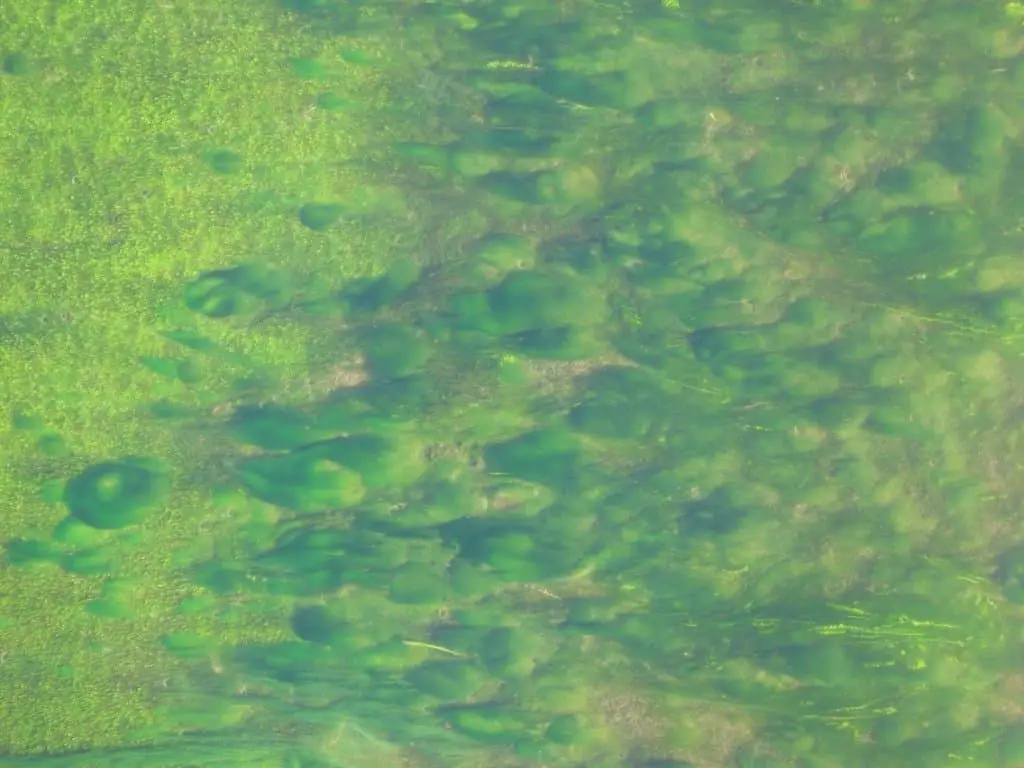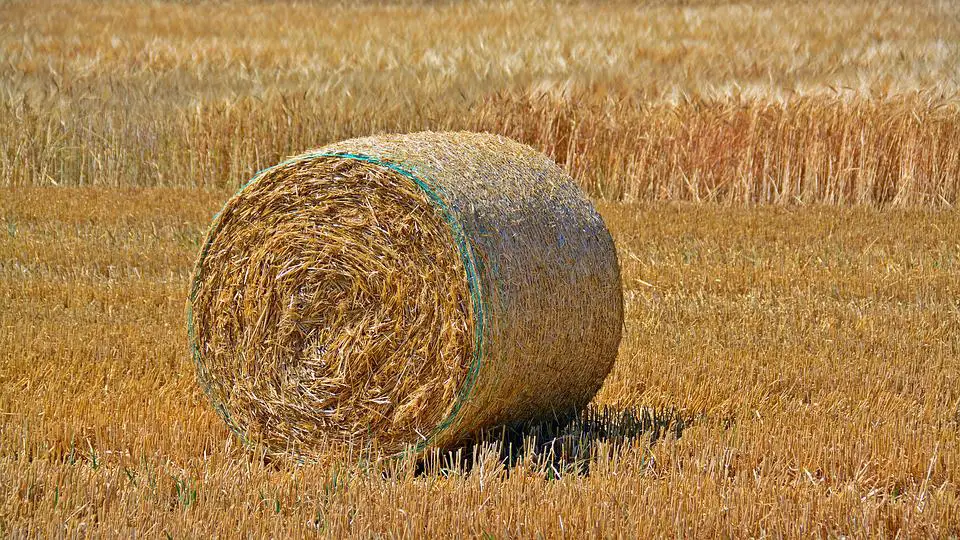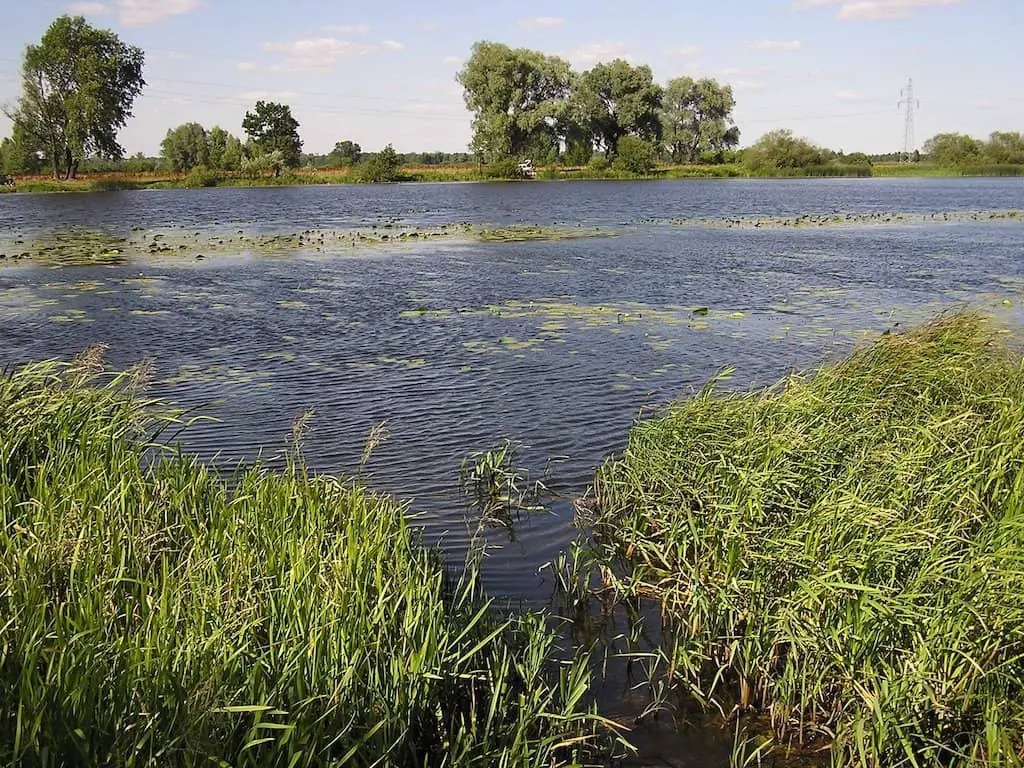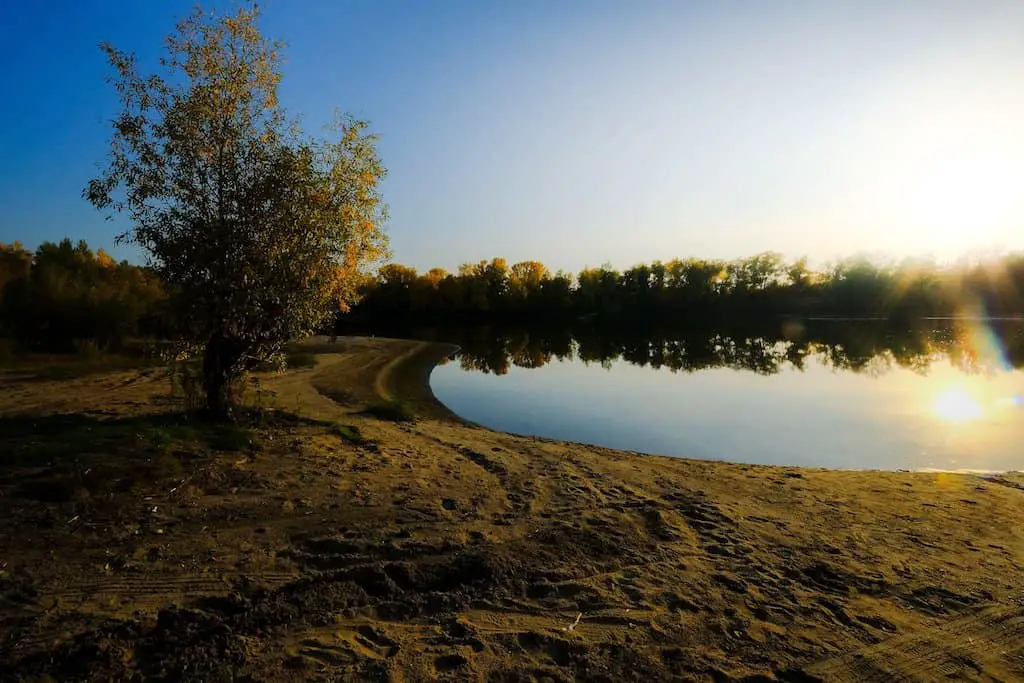For many hundreds of years, barley straw has been used to control algae growth in ponds. There is no official documentation about when the use of barley straw for ponds first began. The story goes that an English farmer was traveling by wagon along his property. A few barley straw bales fell into an algae-ridden pond. This accident proved to be fortuitous for this farmer and others who made their livings from agriculture and farming.
Controlling algae in ponds with barley straw is becoming more common. Studies conducted in England in the 1990s found it to be effective for this purpose. Since that time, its use has spread throughout America by scientists trying to assess its effectiveness and pond owners looking for effective and easy ways to combat algae. Rye or other types of straw are not effective in combating algae.
Barley straw is helpful in controlling algae only and not effective against plants such as duckweed, pondweed, or watermilfoil.
You are probably wondering, “how does barley help my pond”? Let’s discuss what algae are, the problem it causes, and other information that will answer this question for you.
Table of Contents
What are Algae?
Algae are microscopic, free-floating plants that comprise a vital part of water’s food cycle. They are fed upon by tiny creatures called zooplankton, an important food source for fish. Algae color the water brown or green. If the growth is not controlled, it can lead to noxious odors, nuisance surface scum, poor water clarity, and an overall reduction in the body of water’s recreational value.
Algae come in a variety of colors and shapes.
- Chlorophyta – green algae
- Chrysophyta – golden-brown algae
- Euglenophyta – euglenoids
- Phaeophyta – brown algae
- Pyrrophyta – fire algae
- Rhodophyta – red algae
- Xanthophyta – yellow-green algae

A common form is “planktic,” single cells that float in the water and, when abundant, give it a soupy-green appearance. The form “filamentous” grows in hair-like strands forming mats on the water’s surface. While some algae forms have relatively complex shapes that may appear to be higher plants, they do not have roots or leaf veins.
Algae produce oxygen during the day through photosynthesis but stops at night. Algae continue to use oxygen at night, and a large population of algae in a pond can deplete the oxygen supply overnight. This will cause a low-oxygen situation that can be harmful or fatal to aquatic life. Large algae die-offs can also deplete oxygen levels. This is another reason why chemical pond treatments are so dangerous for fish.
Excessive levels of algae occur when phosphorus or other nutrients are in abundance. Take steps to reduce the amount of phosphorus entering a pond to control algae growth directly. Usually, this is accomplished by treating the pond or lake with compounds such as Cutrine Plus or copper sulfate. While these treatments may be useful for short-term control of algae, they are also toxic to food source organisms that are essential for fish, such as insect larvae and zooplankton. We would never suggest using such toxic chemicals in your pond.
Chemical applications are very hazardous to our environment, and they start a vicious cycle of application and re-application as their effectiveness subsides in a short time. The build-up over the long-term of copper in water sediments is an environmental threat and a health concern. It is preferable to use an eco-friendly method to control algae growth. There must be a safe and environmentally friendly way to prevent algae growth. Barley straw is the solution; harmful chemicals are not.

The Algae Growth Problem
Excessive algae growth is a common problem in ponds, and traditional chemical control methods are not advisable due to their adverse health effects and high cost. When applied at the proper time and correct amount, barley straw has been successful in algae control.
The common issue of controlling algae in both larger lakes and smaller ponds becomes more problematic in the summer months. Algae and aquatic plants provide oxygen and food for marine life, including fish. But excess algae in a pond can interfere with swimming and fishing. It can also cause unpleasant odors and other aesthetic problems such as mats of algae on the water’s surface.
Types of Straw Available
Barley is a type of straw used to control algae. But others, such as wheat, linseed, and lavender stalks, can be used as alternatives if barley straw is not available. But they will not be as effective in eliminating algae, nor will they function the same. If you decide to use one of the alternatives to barley, you must increase the application frequency and quantity used. Never use hay to eliminate algae, as it will release nutrients that will encourage its growth.
Barley straw is an acceptable alternative to using copper compounds that have toxic effects on rooted aquatic plants, insect larvae, fish, and zooplankton. It is a cost-effective and environmentally friendly way to control algae in ponds.

How Does It Work?
It needs to be used in a specific way to work. When barley straw is placed in water, it breaks down, and a chemical is released that inhibits algae growth. The breaking down of the barley straw is a microbial process that depends heavily on the surrounding environment’s temperature. The chemical release occurs more rapidly in the summer and slower in the winter.
Initially, the algae may not appear to be affected by the barley straw’s presence, but after several weeks, it will diminish.
While it has been discovered that barley straw prevents algae’s growth, it does not kill algae already present in the pond. Thus, it is an algistat (an agent or substance that inhibits algae’s growth) rather than an algicide (a substance that destroys algae).
It has not been determined how barley straw prevents the growth of algae. It is thought to result from the straw decaying in the water that releases chemicals that inhibit algae growth. Another theory is that the decaying straw feeds certain microbes, which are algae, predators.
Conditions Required for Barley Straw to Work
Adding the barley straw to a pond does nothing until the decomposition occurs. This is called “conditioning,” which depends on several factors such as temperature, being the most important. Once properly conditioned, it will continue to work for many months. Barley straw extract may work faster as it is already conditioned.
The barley straw needs water and oxygen to decay. The straw can be floated on top of the water or just under the surface. The straw can also be placed in waterfall boxes, wetland filters, or under a waterfall. Pond aeration and moving water increase barley’s effectiveness.

How Effective is Barley Straw?
There is positive research-based evidence that barley straw effectively controls some kinds of algae. But which types are controlled? Evidence has shown that barley straw is effective in controlling planktic algae. It clarifies water that is green from algae. Research continues regarding its effectiveness in blue-green algae, filamentous algae, and mat-forming algae. Some testing results are positive for these types of algae.
Where Can You Purchase Barley Straw?
Barley straw is available in full-size square bales from feed stores or farm supply stores. This is an economical way to purchase it, especially when needing larger quantities to treat bigger ponds. Its availability in farm stores may be seasonal, depending on the location. Whole bales can be ordered from retailers online, but the cost is typically more than from a local farm store or feed store. Consult with government or private agencies that work with local farmers, such as Conservation District offices, extension offices, or farm supply companies, to determine if barley straw is available in your area.
You can also purchase various barley straw products for use in smaller ponds, including liquid extracts, miniature bales, and pellets. When purchased in smaller quantities, the barley straw’s cost is typically more per pound than if purchased in full bales. These smaller quantities are appropriate for smaller ponds such as water gardens and koi ponds. These products are available from pond supply stores, garden centers, and online retailers. These are the barley straw bales that we use.
Algae is the pond owner’s biggest problem. People try everything to get rid of it. Farm supply stores or feed supply companies sell barley straw bags in small amounts for the backyard pond.
Barley straw extract can also be used—pond barley’s benefits without the mess. It is sold as “straw in liquid form.”

Barley Straw – It is a Pesticide?
Barley straw is not considered a pesticide by the United States Environmental Protection Agency, so you don’t need a license or permit of any sort to apply it. It is regarded as a home remedy for the private landowner, but only on their private property. Any public property application should be approved by the governing body.
When Should Barley Straw Be Applied?
Because barley doesn’t kill algae, it is best to apply it in early spring, before the algae begin to grow. When applied to cold water, less than 50 degrees, it may take six to eight weeks for the straw to decompose and produce the chemicals that inhibit algae’s growth.
The decomposition process is temperature-dependent and is faster in warmer water. When the straw is applied to water above 70 degrees, it may become effective in as little as one or two weeks. Barley straw will remain effective for approximately three to six months after the application.

Where Should the Barley Straw Be Applied?
Spreading the barley straw in smaller quantities around the pond will improve the distribution of the growth-inhibiting chemical found in the barley straw bale. Place each net of straw equal distances from the shore and other nets. The placement of bags does not need to be exact. In larger bodies of water, practical considerations such as allowances for angling and boating may determine the bags’ placement. In small ponds, where only one net is needed, place it in the pond’s center or in an area where it gets water flow like a wetland, waterfall, or stream.
Barley Straw – How Much Should Be Applied?
The most common application is roughly two or three bales per acre of pond. The pond’s water depth is not a factor unless the pond is adequately aerated, which would circulate the pond water, increasing the barley application levels. In a pond that is muddy or has been known to have heavy algae growth, two or three times the recommended dose may be required for the first treatment. Ensure not to overdose the pond with barley straw as it deoxygenates the water as it decays and may kill the fish. This is especially true if overdosed during a warm spell, but you would need to add quite a bit of barley for this to occur.
Muddy pond water will require more barley straw than a clear pond. Some people have questioned whether the barley straw itself could become a problem with the microorganisms colonizing and absorbing the water’s oxygen. But the decomposition of the straw occurs slowly, and the use of oxygen by the microorganisms isn’t a problem unless large amounts of straw are used that are more than most pond owners will ever need. If you have a muddy pond, it is highly recommended that it be heavily aerated and treated with bacterial tabs to reduce the sediment levels.
The amount of straw required to control algae’s growth depends on the surface area of the pond. Ponds that historically have problems with algae need treatment at a ratio of 225 pounds of straw per surface acre. This rate is about 0.8 ounces of straw per ten square feet of pond surface area. You can try lower doses, but do not fall below 90 pounds of straw per acre or 0.3 ounces per ten square feet.
The straw is less effective if it is in muddy water, so a higher dose is recommended in bodies of water that are incredibly muddy or have very severe algae problems. In this case, apply 450 pounds per acre but do not exceed 900 pounds per acre. The straw requires oxygen to decompose, so using amounts greater than 900 pounds per acre could significantly reduce the oxygen content that could kill or stress fish.
As the algae begin to subside, the amount of barley straw can be reduced.
Calculating the Amount of Straw Required
The following example will determine the amount of straw required to treat a pond of five acres that does not have an excessive amount of algae or is not too muddy.
- The pond’s surface area is five acres; therefore, the selected dose is 225 pounds of straw per acre.
- So, multiply acres by pounds. For example – 5 acres x 225 lbs./acre = 1125 lbs.
- To calculate the number of bales required, divide the total amount of straw needed to treat the entire pond by the single bale weight. The bales vary in weight, but 45 pounds is probably average. For example – let’s say that one bale weighs 45 pounds – 1125 lbs ÷ 45 lbs. = 25 bales.

How is the Straw Applied?
Large Pond Application:
It is essential that the bales are appropriately placed in the pond for maximum effect.
- The strawbales must be broken apart first. If the bales are too tightly packed, it will not allow for adequate water movement through the straw since many large ponds lack proper water movement or aeration.
- The loose straw should be placed in some type of netting. For larger ponds, wrap the straw in the cylindrical netting used for wrapping Christmas trees. This type of netting can be used for straw-filled tubes up to 65 feet long and can contain about 110 pounds of straw.
- For smaller ponds requiring less straw, use loose woven sacks, such as onion sacks or nylon stockings.
- Suspend the straw-filled netting with floats in the first three to four feet of the pond. If it sinks below this depth, the straw will not be as effective. The water movement near the surface will keep the straw properly oxygenated while distributing the growth-inhibiting chemical throughout the pond’s upper portion.
- It is recommended that the floats be inserted inside the netting when the netting is filled with straw. The netting is then anchored in place using a rope attached to concrete blocks or bricks.
Small Pond Application
- For small, lined backyard water garden ponds, it is generally recommended that approximately 16 oz of barley straw will effectively treat up to 5000 gallons for up to three months.
- Barley for small ponds is often sold in mesh bags or fully biodegradable bags. The biodegradable bags are typically preferred as the entire bag and barley straw can be left to fully decay in the pond and will not require cleanup or removal.
- The straw needs water flow to decompose properly, so place the barley bags in the pond’s waterfall box, wetland filter, or stream to ensure maximum water flow through the barley straw. In ponds lacking any of the above features, place the barley near the circulating pump or the aerator to provide the necessary water movement and oxygen for proper decay.
Other Ways to Control Algae in Ponds and Lakes
Excess algae growth is promoted by an increase of nutrients in the water, particularly phosphorus. All runoff water of any sort will carry nutrients, especially from pastures, farms, fertilized lawns, roads, malfunctioning septic systems, or wildlife excrement.
To reduce the algae growth in a pond, you need to increase oxygen and decrease nutrients.
- Use surface aeration to disperse the algae and to minimize the effects of die-offs.
- Remove filamentous algae with rakes or nets.
- Use bottom aeration for increased water oxygenation and reduction in long-term sediment build-up, which will reduce nutrients.
- Divert nutrient-filled runoff from entering the body of water.
- Prevent large groupings of geese and other wildlife from frequenting the body of water. A few is fine; a bunch is a problem.
- Treat runoff with buffer strips of grass or vegetation before it can enter the pond or lake.
- Reduce phosphorus fertilizer use from nearby lawn areas.
- Apply bacteria and enzyme tablets to help break down debris and reduce overall nutrient levels.
Every pond owner deals with algae at some point. While there are many products available, the best alternative to controlling algae naturally is organic barley straw. Help save the earth naturally by not using chemicals. Organic barley straw is by far the best option!


